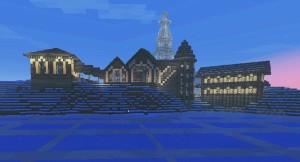By Matt Waite
Staff Writer
Minecraft is a game where players gather resources of varying rarity to build whatever they want, while staying alive from the various monsters who come out during the night.
The Minecraft Club was founded this year by sophomores Zafer Estill and Tyler White, who presented math teacher Seth Risinger with the idea after they noticed he had Minecraft on his laptop.
They then had to put together a presentation for Principal Chris Blice to show that Minecraft is educational, demonstrating how math is used to build scale models, how it teaches learning through unconventional means and by showing some of the creations they had made.
Although the club is official, it still has to get approval from the Technology Committee, because Minecraft is a blocked application. To continue, the club will most likely require the purchasing of educational copies of the game.
“There is a small movement of using Minecraft in education that is starting to take off and they’re offering educational discounts,” said Risinger. “So what it kind of sounds like, is that if we can get approved and have the funds to purchase it officially, that might make the difference between approved and not approved.”
To raise the funds to purchase copies of Minecraft, the club is planning on instituting membership dues and selling Minecraft t-shirts to its 12 members.
The club’s goal is to bring together the different people who play Minecraft at Northwood to collaborate on projects and showcase some of their creations.
According to White, the game’s popularity can bring together people who normally have disparate interests and give them common ground.
“You can have people who like to play Minecraft in completely different social groups, you can have someone on the football team and then someone in Anime Club, whatever. Just completely different people come together to play,” White said.
Minecraft, which was designed by a single person, has sold over four million copies and created a die-hard fan base. This success has confused some outsiders who have not played the game and wonder how it has managed to draw in so many players and retain them. The answer is quite simple: players like having the ability to explore the endless world and build whatever they want.
“There’s no limit to the game; you keep going and your imagination is what keeps calling you back,” Estill states.
Risinger also sees the appeal.
“I like its simplicity and its complexity at the same time,” Risinger said. “I like that there are no rules and that it’s very simple but at the same time I am able to create whatever I want and am free to explore at essentially no penalty.”
The game gives players complete freedom in a world without quests or objectives and requires players to set their own goals. The world is generated by the game, which allows for an endlessly large game world, no matter how far the players explore. The player is then given free reign to harvest materials to build whatever they can imagine, which has included impressive 1:1 scale replicas of Hogwarts, Minas Tirith and The Star Trek Enterprise.
However, many people prefer to use their creativity to create unique structures, such as White, who has made villages, towns, farms and castles.
“I just like building whatever, I don’t really replicate anything; I just build whatever I have on my mind,” said White.
Risinger has been impressed with his students’ creations.
“Some students in our club have just incredible worlds with restaurants, houses, castles, incredible railway systems, and deep cavernous mines and I would love to have all that. It’s an issue of time,” Risinger said. “If you’re going to build a castle you’re committing yourself to a large project and you just need to make sure you’re ready for that. So I’m starting small; I’m starting with little houses for a village and slowly, maybe eventually, I’ll have a massive castle. But right now I’m on a much smaller scale than some of my students.”
The Minecraft Club still faces difficulties with financing and gaining approval of the Technology Committee, but Risinger thinks that it should be approved.
“We wanted an opportunity to share our ideas within the school world, because whether we admit it or not, the students want to play Minecraft and we’re looking for a way to show our creations within the school rules,” he said.

